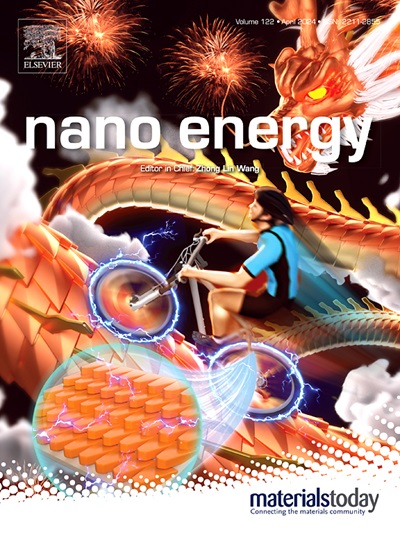Adsorption-induced surface potential modulation and electron transfer of solid-solid triboelectric nanogenerators under gas atmospheres
IF 16.8
1区 材料科学
Q1 CHEMISTRY, PHYSICAL
引用次数: 0
Abstract
Environmental factors have a significant impact on triboelectric charging, such as temperature, humidity, and pressure. The atmosphere also influences the output of TENGs, but this is often overlooked. To investigate how the atmosphere affects the output of TENGs under atmospheric pressure, a sealed system was constructed to create homogeneous atmospheres of air, O2, N2, and Ar. It was found that under a humidity of 20% RH, the TENG achieved maximum output in air. Then, the volume ratio of oxygen to nitrogen is refined, finding that the TENG achieved the maximum output at a ratio of 2:8. To explain how gases affect the output of TENGs, a mechanistic analysis was provided from three aspects: charge generation, accumulation, and dissipation. DFT calculations suggest that different gases have varying adsorption capacities on the contact surface, which alters the surface free energy of the solid, thereby changing the surface potential. The adsorption of gases modifies the relative positions of the HOMO and LUMO orbitals, affecting the energy difference and thus influencing the ease of electron transfer. This leads to changes in the generation and accumulation of triboelectric charges. Simultaneously, the measured charge dissipation rates exhibit certain variations, indicating that different atmospheres also have varying effects on charge decay. Furthermore, the output patterns of TENGs were also studied in different atmospheres at higher humidity and temperature levels. Finally, based on the different output signals of the TENGs in various atmospheres, a gas detection sensor was designed that can be used to identify different types of gases.

气体环境下固-固摩擦电纳米发电机吸附诱导的表面电位调制和电子转移
环境因素对摩擦充电有重要影响,如温度、湿度、压力等。大气也会影响到teng的产出,但这一点经常被忽视。为了研究大气压下大气对TENG输出的影响,我们构建了一个密封系统,以创造空气、O2、N2和Ar的均匀气氛。结果发现,在湿度为20% RH时,TENG在空气中的输出最大。然后,细化氧气与氮气的体积比,发现TENG在2:8的比例下达到最大输出。从电荷产生、电荷积累和电荷耗散三个方面分析了气体对TENGs输出的影响。DFT计算表明,不同气体在接触面上的吸附能力不同,这改变了固体的表面自由能,从而改变了表面势。气体的吸附改变了HOMO和LUMO轨道的相对位置,影响了能差,从而影响了电子转移的容易程度。这导致摩擦电荷的产生和积累发生变化。同时,测量到的电荷耗散率也有一定的变化,表明不同的大气对电荷衰减也有不同的影响。此外,还研究了在不同湿度和温度水平下,TENGs的输出模式。最后,根据TENGs在不同大气环境下的不同输出信号,设计了一种可用于识别不同类型气体的气体检测传感器。
本文章由计算机程序翻译,如有差异,请以英文原文为准。
求助全文
约1分钟内获得全文
求助全文
来源期刊

Nano Energy
CHEMISTRY, PHYSICAL-NANOSCIENCE & NANOTECHNOLOGY
CiteScore
30.30
自引率
7.40%
发文量
1207
审稿时长
23 days
期刊介绍:
Nano Energy is a multidisciplinary, rapid-publication forum of original peer-reviewed contributions on the science and engineering of nanomaterials and nanodevices used in all forms of energy harvesting, conversion, storage, utilization and policy. Through its mixture of articles, reviews, communications, research news, and information on key developments, Nano Energy provides a comprehensive coverage of this exciting and dynamic field which joins nanoscience and nanotechnology with energy science. The journal is relevant to all those who are interested in nanomaterials solutions to the energy problem.
Nano Energy publishes original experimental and theoretical research on all aspects of energy-related research which utilizes nanomaterials and nanotechnology. Manuscripts of four types are considered: review articles which inform readers of the latest research and advances in energy science; rapid communications which feature exciting research breakthroughs in the field; full-length articles which report comprehensive research developments; and news and opinions which comment on topical issues or express views on the developments in related fields.
 求助内容:
求助内容: 应助结果提醒方式:
应助结果提醒方式:


